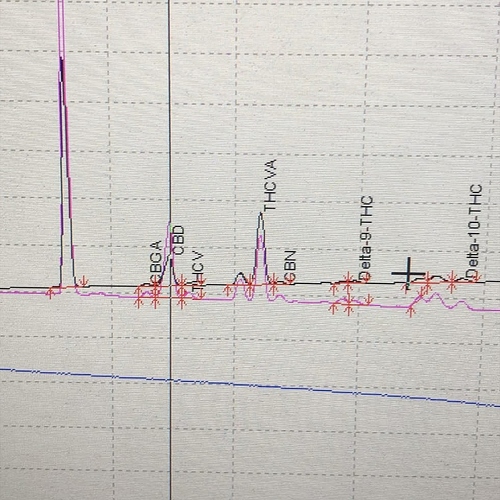And snugly in heating mantles
It’s interesting that you are using the 285nm wavelength. That’s the same that is used to destroy bacteria, amongst other things, with uv-sterilization. I came across it when dealing with mites and wanted to see if we could use uv against them.
It had not occurred to me that it could be used for isomerization. How did your experiments go?
@krative tell this guy about that reaction I talked to you about to open the bottom ring to make cbn into cbnd
Its not viable bro the yield will be so bad itll be ridiculous
Starting with cbd and oxidizing it how you oxidize thc into cbn would be a much better way
Im actually trying this today and gonna get kca to test it
Ye carbon carbon bond making/breaking pathways suck major donkey balls
yeah, you aren’t going to open a pyran ez pz.
Did the experiment ever happen? Would love to hear results.
Out of context, the mental image of someone “ordering light” cracked me up. Like shouting at the sun for more 253 nm radiation while shaking both fists angrily.
The light didn’t do anything spectacular
My hope is loading higher 25% dehydrogination reagents In the flask on dmso and sparging the reaction with a innert gas for CBN-D or with H2 for HHC
I just wrapped up my labs for I am moving
To a new location and will proceed with trails
I agree dehydrogenation of cbd is the only way to go.
Right on man, hope the transition is smooth to the new place. Dehydrogenation reagents can get expensive and metal waste isn’t so good either, it may be worth attempting to find a way to increase the catalyst loading on the solid support (presumably carbon) say by a factor of 2 rather than increase the overall solid loading by say a factor of 5.
Yaknow what I mean? Like if for some batch size 1000 mg of 5wt% metal on carbon (50 mg metal+950 mg carbon) isn’t cutting it…it’s cheaper to use 1000 mg loading of 10wt% metal on carbon (100 mg metal+900mg carbon) than to use 5000 mg of 5% metal on carbon (250 mg metal+4750 mg carbon).
The premise of this technique is that you do not suffer from a lack of homogeneity or carbon in your heterogeneous reaction - at some threshold loading you have enough carbon floating around in there that (with mixing, obviously) it provides sufficient and equal opportunity for substrate to encounter carbon/metal and for the reaction to occur if it is going to occur. However, reactions are enouraged by increasing the concentrations of the reagents through sheer probability and supply of interaction, if not kinetically via rate laws (unless one reagent is zero order). The carbon itself is not doing any work for you in performing the dehydrogenation, often you must increase the overall loading of metal to see a fast or complete reaction. But it can be better achieved by increasing efficacy of the catalyst loaded than by continually increasing the overall mass of catalyst loaded.
In the same vein, it is worth exploring various zeolite catalyst supports which are commonly used to make heterogenous catalysts more effective at lower loadings of catalyst on solid support. 1% metal on zeolite might kick the shit out of 5% metal on carbon.
So @Roguelab is the only person on the forum confirmed to have made this compound? Or has anyone else dabbled with success?
I know there are several papers that indicate a psychoactive effects most similar to THC, but the results in these publications are subjective and not convincing; also I have not seen a study with human test subjects.
It’s 2020, I need some qualitative data on someone’s CBN-d “liberty-bioassay.” There are plenty of “free-will lab rats” out there. Where’s the data?
If you’re a fan of liberty, a good method to assay this compound is using the old “lung to prefrontal-cortex gas chromatography interface” (LPC-GC). The molecules are vaporized into a gas and subsequently pulled into the system via a biological diaphragm pump. Once the vapor is pumped in the “lung apparatus“ the molecules diffuse through a lipophilic membrane and enter a network of microscopic tubular channels where the molecules solvate and are instantaneously transported to sets of molecular sensors/detectors within a device called the “prefrontal cortex.” These sensors transmute the molecular imprint into a unique electrical signal, which can be interpreted and characterized by the systems quantum computa.
This will only work if your firmware has been recently updated and it’s also recommended to have a new operating system… otherwise things have the potential to get WEIRD
What is the margin for error for such a system?
Depends on the personal system. The one I have is extremely precise with a vast array of sensors that rarely malfunction. Though I have seen older systems that were operating at only 20% sensor capacity (poor resolution). Also saw one system with a broken diaphragm pump, so SAD.
Hence why it’s found in distilled D9.
As long as you don’t add something to act as the terminal oxidant, that’s going to fail.
you must have amassed quite a lot of testing sandards to be so precise!
Cool, have you run the LPC-GC yet? Results? ![]()
I like that THCv spike!
Its not THCV is definitely a mislabeled peak
